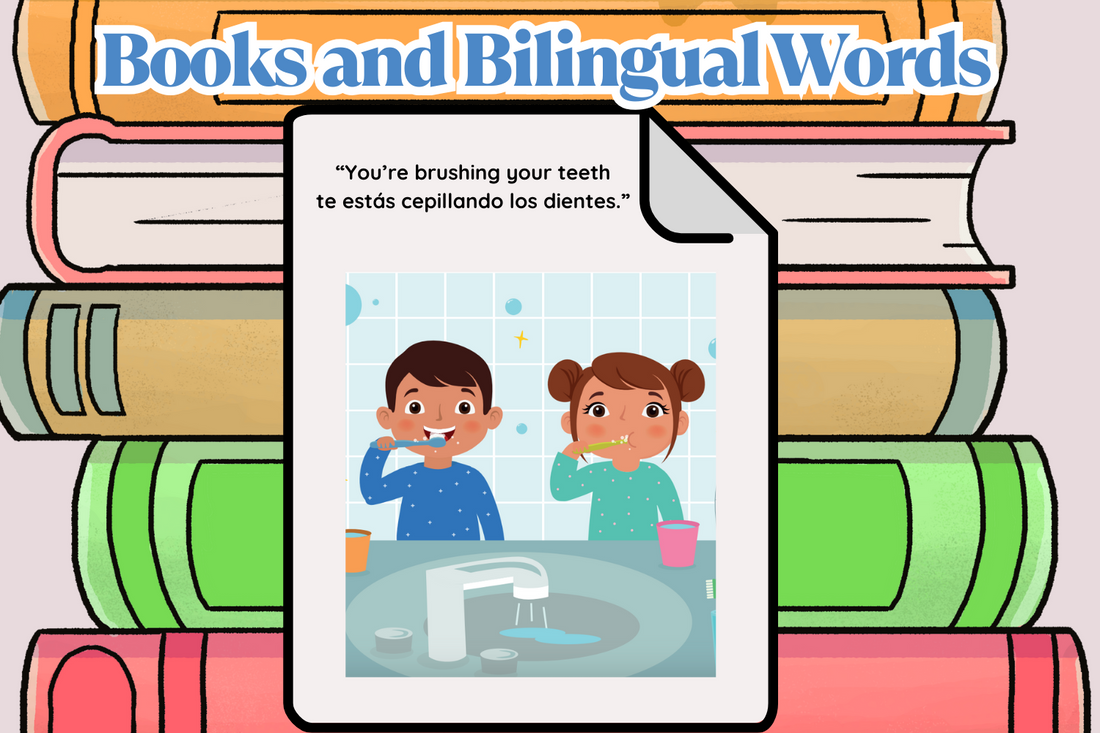
Books and Bilingual Words: Easy Ways to Introduce Two Languages at Home
Simple, Everyday Strategies to Support Bilingual Language Development
Whether you're raising a bilingual toddler, trying to reconnect with your roots, or simply want to expose your child to Spanish and English from a young age—you don’t need a formal program to get started.
At Growing Juntos, we believe that language grows in everyday moments: at breakfast, during storytime, while putting away toys, or even while brushing teeth. When we approach bilingual learning in a natural, consistent way, it becomes part of your child’s world—not something extra.
Here are gentle, practical ways to introduce two languages at home, especially for families with toddlers and preschoolers.
1. Start with What You’re Already Saying
You don’t need a full lesson plan to start using both languages. Begin by adding familiar Spanish or English words into everyday routines.
Try this:
- “Let’s wash hands — lavar las manos.”
- “Your shoes — los zapatos — go by the door.”
- “Time to eat! ¡A comer!”
It’s okay if you only know a few words to begin with. Repeating them naturally helps toddlers connect the dots. Pick 5–10 core words and repeat them in context during routines.
2. Choose Books with Side-by-Side Text or Bilingual Themes
Books are one of the most effective tools for introducing a second language. Look for bilingual board books with both languages printed clearly on the page, or books that center cultural or language themes.
Great picks include:
· Paletero Man by Lucky Diaz – a rhythmic, street-level story rich in cultural pride
· Lotería by Lil’ Libros – a top-rated bilingual board book introducing vocabulary through the beloved Mexican game, perfect for introducing new words visually
· Language Explorers series by Growing Juntos – supports toddlers in naming, exploring, and connecting with their everyday world through simple bilingual storytelling📌 Pro Tip: Read in your stronger language first, then go back through and introduce the second language. Pause to point to words, repeat them, and ask questions like “What’s that in Spanish?”
3. Use Songs and Routines to Reinforce Vocabulary
Young children naturally respond to rhythm, rhyme, and repetition—three things that songs offer in spades. Add bilingual songs to your daily routines to introduce verbs, feelings, and commands.
Try:
-
"Buenos días ¿Cómo estás?” (Good morning. How are you?) as a morning greeting song
-
A clean-up song in Spanish: “A guardar, a guardar…” (Clean up, Clean up)
Even 1–2 songs a day build exposure and comfort. Repetition is what makes the difference.
Also helpful: Lovevery Let’s Map It Out Routine Cards – great for bilingual play-based labeling
4. Narrate in Both Languages
One of the best ways to introduce new words is through narration—describing what your child is doing or seeing, in real time.
You can say:
- “You’re brushing your teeth—te estás cepillando los dientes.”
- “We’re putting on socks—los calcetines.”
Start by repeating in both languages, then gradually pause to let them try the second word. No pressure—just model and keep going.
5. Create Gentle, Daily Exposure
The key to raising bilingual children isn’t perfection—it’s consistency.
You don’t need to speak fluently to model bilingual exposure. What matters is showing your child that both languages are part of life.
Try this rhythm:
- One bilingual book a day
- 2–3 phrases during routines
- One song in Spanish during bath or clean-up
- Label 1–2 things in your home this week (mesa, puerta, ventana)
Over time, this casual exposure leads to vocabulary growth, comfort with code-switching, and even bilingual confidence.
Final Thoughts
Bilingual learning doesn't need to feel like a chore or formal lesson. When woven into storytime, play, and daily routines, it becomes something your child looks forward to.
Even if you're just getting started, every word counts. Every book, every phrase, every silly song builds the foundation for a child who hears, speaks, and understands more than one language.
Explore more bilingual resources and Growing Juntos books designed for toddlers at GrowingJuntos.com
